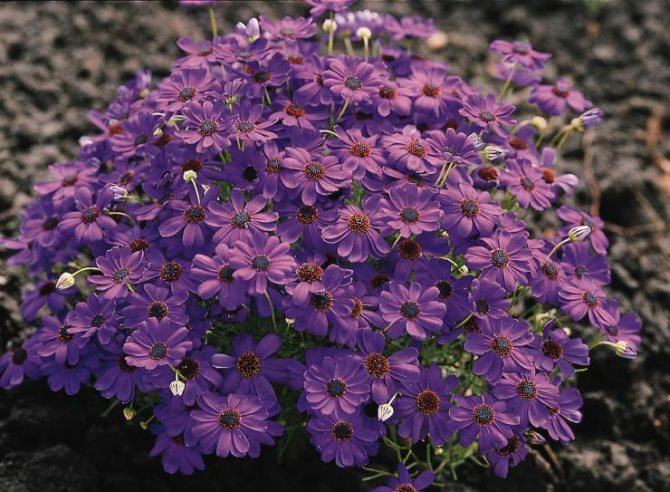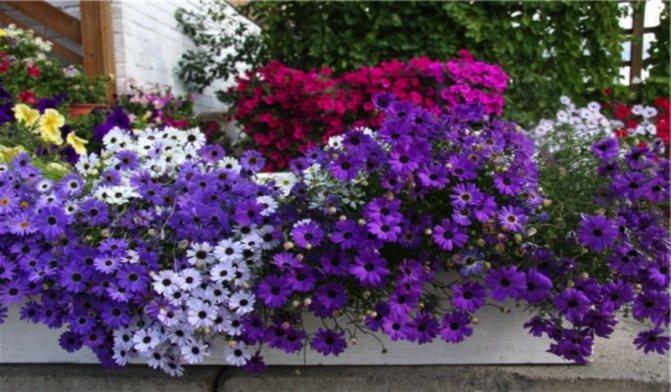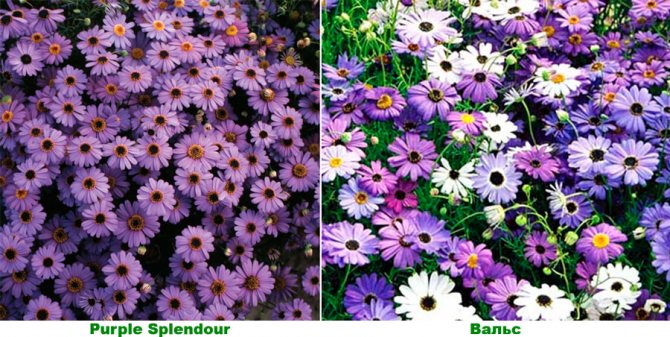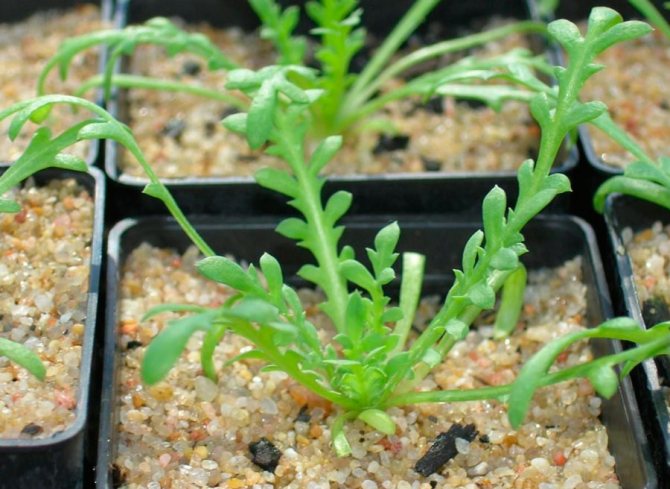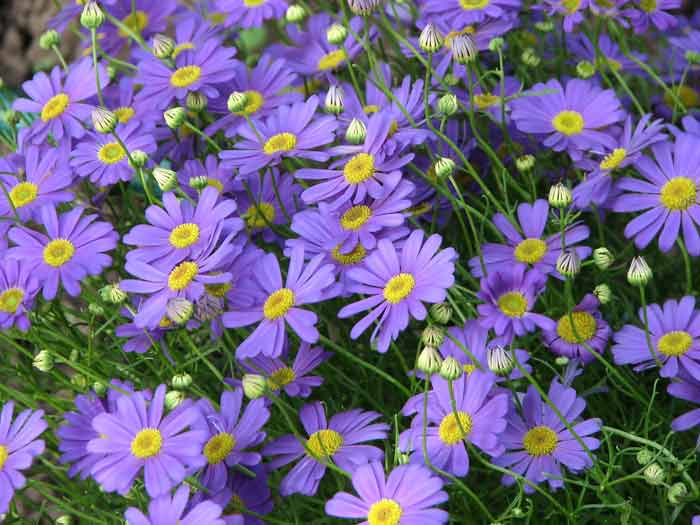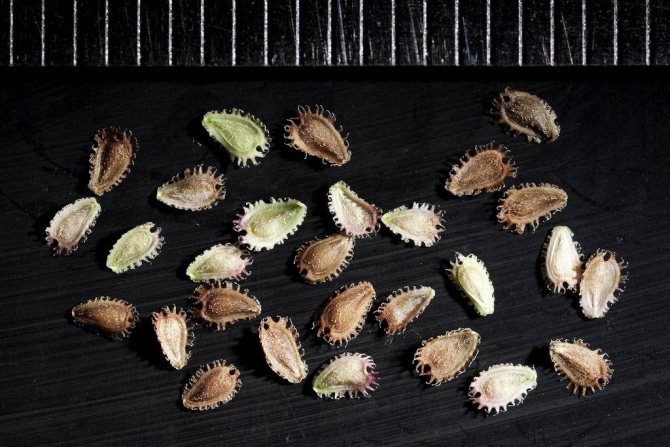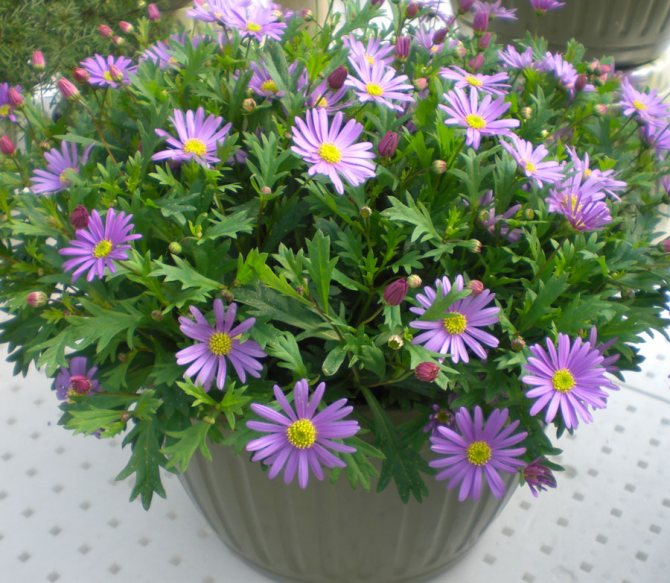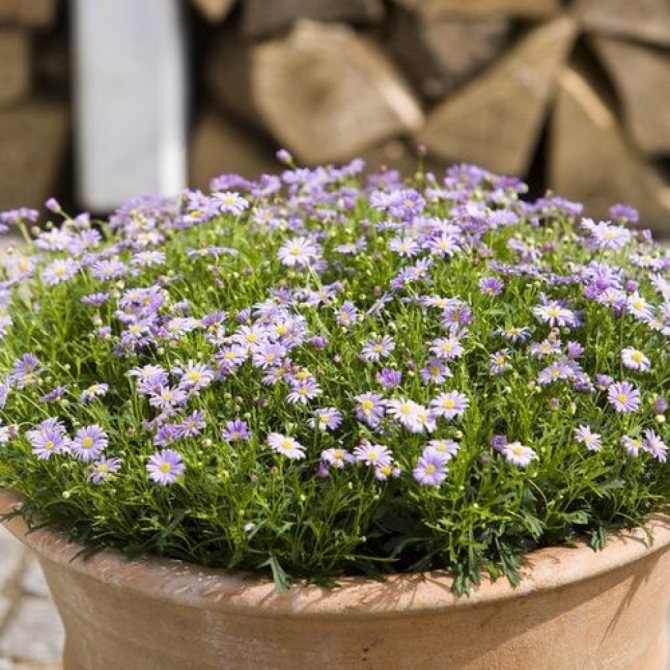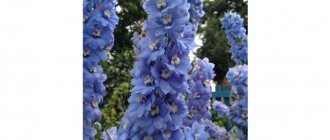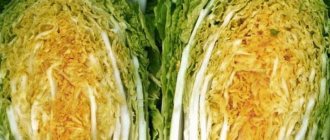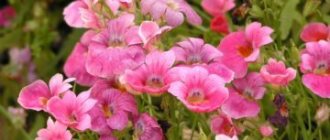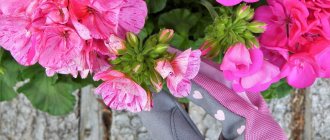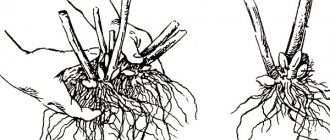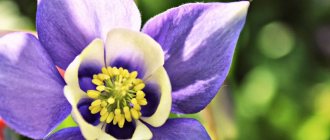The homeland of these unusual flowers is hot Australia, Tasmania and New Guinea, but they moved to the European continent long ago, and they feel good there, being regulars of many gardens, parks and squares. In Germany, brachycea is called a blue daisy.
Blooming brachycoma is a delightful sight - many inflorescences - miniature "daisies" on a fluffy bush, exuding a pleasant aroma. This is a worthy decoration of any garden - the whole season pleases with juicy openwork, like green dill, foliage and a bouquet of charming little "daisies".
Description of the brachycoma plant
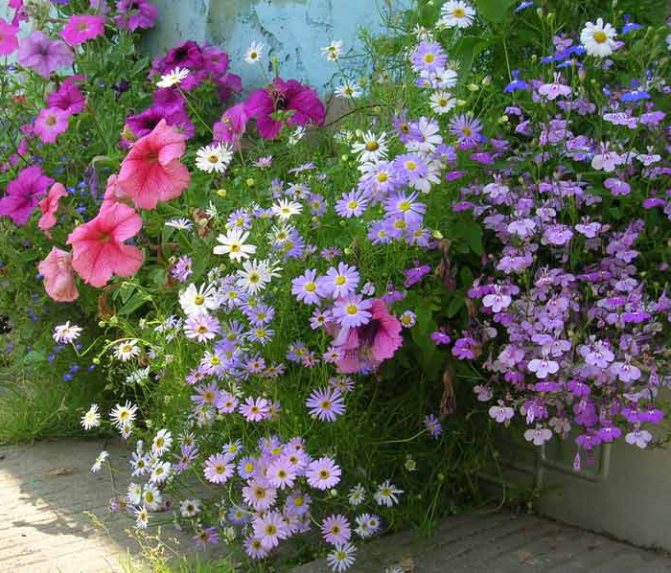
Brahikoma in landscape design photo in a flowerbed
Brachycome is a branching perennial plant of the Asteraceae family. The name comes from two Latin words that translate as "short hair", which indicates the presence of tuft-shaped bristles on the seed. In the middle lane, this beautiful flower, originally from Australia and New Zealand, is grown as an annual plant, as it does not tolerate cold winters. The stem is only 25 cm high and branches strongly and forms a compact bush.
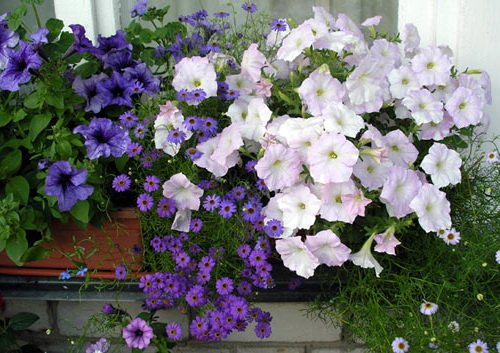

Brachikoma on the balcony photo
The leaves are unusually bright, emerald green, pinnately dissected and look lacy. Inflorescences - baskets with tubular, ligulate flowers, painted in a multi-colored range from white to purple. Flowers - the real pride of the brachicoma - can be simple and terry in a variety of colors. It blooms profusely from mid-summer to frost, not only in sunny but also in cloudy weather.
Looks great, decorating flower beds, borders, rock gardens. Suitable for landscaping balconies and verandas - successfully grown as ampelous in hanging baskets, as a container crop. It goes well with different plants - against the background of decorative deciduous, it attracts attention with a bright spot. Unpretentious and modest. It is valued for its abundant, long-lasting flowering.
Brief historical information
The history of the flower began at the end of the 17th century - it was then that the British naturalist (and also a famous navigator and pirate) William Dampier, brought the plant to Europe from Australia. It is not known how this wild-growing chamomile captivated him (at that time the plant was not cultivated), but it interested the public and already in the 19th century was very widespread in European gardens. Then interest in the plant fell somewhat (plants come in and out of fashion - this is a natural process), but today it is again popular. Breeders also took an interest in it, although at the moment no cardinally new varieties have been obtained. Nevertheless, almost every domestic agricultural company produces brachicoma seeds, and they are readily available for sale.
Planting and caring for a brachycoma Growing conditions
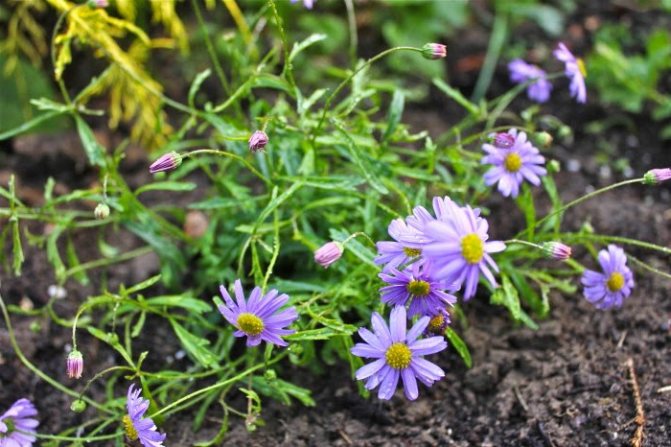

Brachikoma cultivation from seeds Photo of seedlings planted in open ground
Brachicoma should be planted on light, aerated, fertile soils with neutral acidity. Prefers good lighting, bright sunlight. It tolerates light shading, while the bushes stretch out a little. When placed in containers, drainage is required.
- They are planted shallow to fully accommodate the roots of the seedlings, but not to deepen the root collar.
- The distance between the bushes is 30-40 cm, so that the plants are spacious and they can fully develop. At the same time, the decorativeness of the flower bed will be much higher in comparison with thickened plantings.
- Abundant watering is necessary when there is no rain and in the phase of active growth.
- After watering, it is advisable to carry out loosening in order to provide additional air access to the roots. Excess moisture causes decay.
- In rainy weather, it is worth sprinkling the soil around the bushes with ash, thereby protecting the planting from slugs.
- Top dressing is carried out during the period of active growth with nitrogen fertilizer. When the plant is picking up buds - with potassium-phosphorus fertilizer every two weeks, which contributes to a lush, more abundant, high-quality flowering. It reacts negatively to feeding with organic matter, which can even cause the death of the plant.
The decorativeness of the bushes is supported by regular pruning.... Dried shoots and faded buds should be removed. Pruning triggers a new wave of growth and flowering. A few wilted flowers can be left to collect seeds. But the plants grown from these seeds may not repeat the parental traits - the next year, when planted, a lot of new and varied flowers will turn out.
Diseases, pests, problems
The plant works well even with novice florists. Defeat by disease or disease is very rare. Sometimes damage by whitefly or snails is possible (it is enough to collect them by hand)
Also, a flower planted in dense, too moist soil, with a tendency to stagnate water and sourness, will grow poorly. Perhaps the plant will not be so lush in a very cold and rainy summer (at this time, watering should be minimized) - the stems of such plants rot, they shrink, bloom poorly.
Growing brachicoma from seeds at home
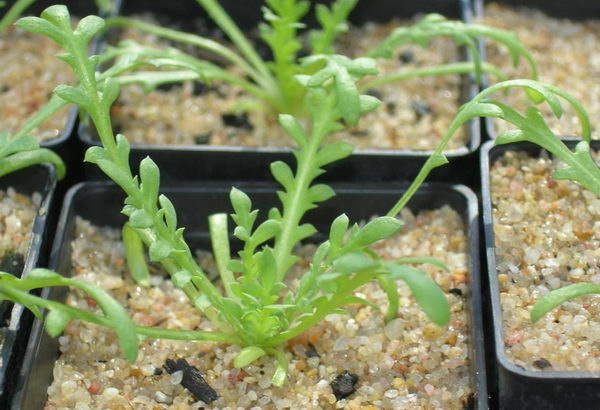

Brachycoma growing from seeds when to plant Seedling photos
Seeds collected from the bush in the fall remain viable for 3 years. When purchasing seed in garden centers, you should pay attention to the information on bags with seeds - the closer to the extreme figure, the worse the germination. In southern latitudes, brachycoma can be sown directly into open ground.
When to plant brachicoma?
To the north, it is better to use the seedling method, since the brachycoma will bloom no earlier than 2 months after sowing.
- Sown in March-April in planting containers with a light, moist substrate.
- Small seeds are evenly distributed over the surface, without falling asleep with soil.
- Placed in a plastic bag or covered with a transparent lid, placed in a warm place.
- When shoots appear (5-7 days), the film is removed, and the container is rearranged closer to the light.
- They dive when 3-4 true leaves appear on the sprouts, the brachycoma transplant is painless. But nevertheless, this is a laborious operation, young plants are very small and tender.
- If you want to avoid picking, sow 4-6 seeds in separate cups or peat tablets. After germination, as it grows, such seedlings are looked after in the usual way, you just need to gently sprinkle the earth between the growing seedlings little by little.
- Water should be done with care, avoiding overflow. It is convenient to do this with a syringe or a watering can with a narrow spout, it is good to spray it from a spray bottle.
- You can pour water into the edge of the container - so it falls directly to the bottom of the container and then distributes itself.
- In order for the bushes to be lush in the future, you should pinch the top of the seedling over 5-6 leaves.
- The brachycoma is transplanted to the beds after the establishment of warm weather. Before this, young seedlings should be hardened - to accustom them to open air a little for a week or two before planting.
How to sow brachicum for seedlings, we look at the video:
Brachicoma seedlings are planted, carefully releasing it from the cups, with a lump of earth. If the seedlings did not grow one at a time, you should be very careful to separate them without damaging the roots. The holes are prepared in advance so that the roots do not get windy.Plants are planted at the same level so as not to deepen the root collar. Considering that the bushes grow powerful, the distance between them is 30-40 cm, so that there is enough space for the full development of the plant.
Picking
Brachicoma sprouts tolerate picking perfectly, although this is a jewelry operation. You can grow seedlings without picking - in this case, 2-3 plant seeds are sown in peat pots. Water gently, watering the seedlings with a spray bottle (stream position, not spray).
Transplant into open ground - at the end of May, by this time the seedlings may already have buds. Plants tolerate transplanting well. The distance between plants is 20 cm.
The plant reproduces well by self-sowing, which is why sometimes brachycoma is included in the lists of the most unpretentious perennials. Although, of course, hybrid varieties will not convey their traits.
Propagation by cuttings
Brachycoma in warm countries is a perennial, so nothing prevents the plant from preserving until spring, providing it with a suitable wintering. The plant is dug up, cut off, transferred to a cool and bright room, rarely watered, only so that it does not dry out. In winter, it will be possible to cut the cuttings and root them - this method of reproduction will allow you to get faster flowering plants, without the need to fiddle with seedlings and seeds.
Pinch seedlings 5 cm high, this provides better branching and a beautiful spherical shape for the plant.
On sale you can often find varieties "Palermo" and "Swan Lake". Growing them is no different from growing any other varieties of brachicoma, you can safely follow the recommendations in this article.
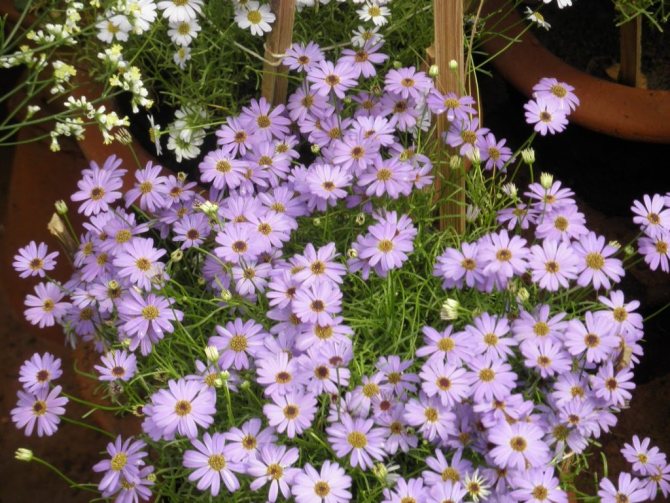

Propagation of brachicoma by cuttings
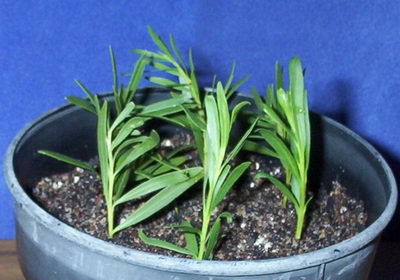

How to grow a brachicoma from a cutting photo
An adult bush at the end of summer is carefully transplanted into a pot. Until the cold weather it can be kept in the garden, caring for it as usual. When it gets cold, it is cut off, removing most of the crown and transferring it to a cool room, where it is kept until spring. Watered little by little.
In the spring, cuttings 8-10 cm long are cut, the lower leaves are removed from them, lowered for 5-6 hours in a root solution and placed in wet sand for rooting. After the formation of roots, they are planted in a container with nutrient soil. In warm climates, brachycoma is grown as a perennial plant, covered with spruce branches or moss for cold weather.
An open sunny area is an ideal place for a brachicoma, light partial shade is acceptable. When planting, young bushes are placed at a distance of 20 cm. If the seeds were sown directly into the ground, the seedlings can be planted.
When planning planting, you can take into account that brachycoma is ideally combined with petunias, marigolds, gailardia.
Soil type
Any light soil that contains enough nutrients will do. To improve the soil for planting, experts recommend taking a mixture consisting of humus, leafy earth and sand. Drainage, consisting of rubble, will be useful.
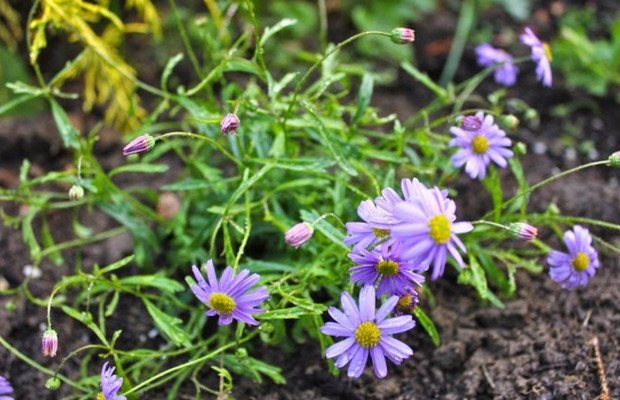

Types and varieties of brachicoma with descriptions and photos
In places of natural growth - Australia, about 50 species of this plant are known, but two of them are most commonly used by flower growers - Iberis-leaved and multifarious, on the basis of which breeders have developed various, numerous varieties.
Brachikoma Iberisoliferous Brachyscome iberidifolia
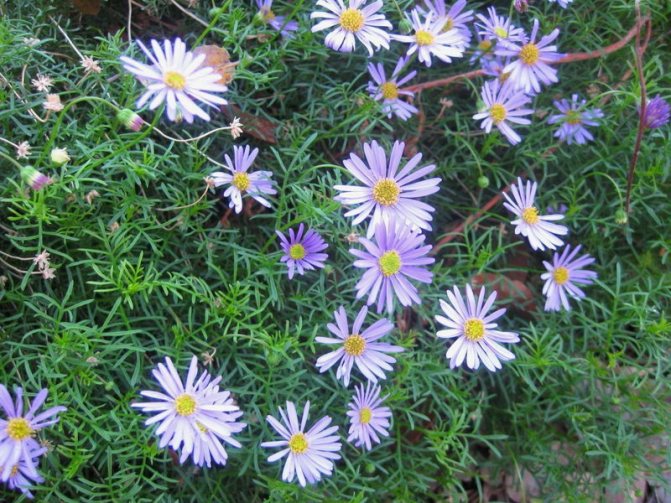

Brachycoma Iberisolate Brachyscome iberidifolia photo
A low-growing openwork plant is the most common in household plots. The height of the bush is 45 cm, the tops of the stems are crowned with flowers. An important condition is its obligatory pinching at the seedling stage so that the bush does not stretch out. The specific name indicates the similarity of foliage with evergreen Iberis.
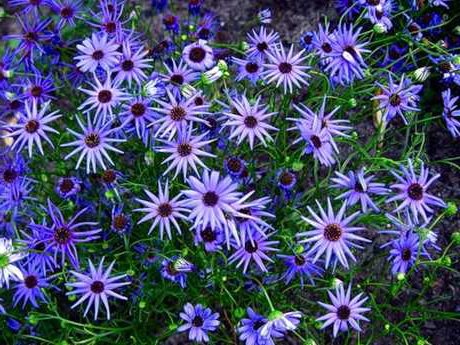

Brachikoma Blue Star photo
"Blue Star" - suitable for growing in hanging baskets and pots;
Brachikoma blue baby
The blue baby is a highly branched plant 15-25 cm high. Violet-blue ligulate flowers envelop a tiny bush. Used for flower beds, ridges, rocky hills.
Brachycoma Waltz photo
Waltz is a mixture of pale blue, pink, lilac flowers with a dark center. Excellent decoration of borders, flower beds;
Brachikoma Swan Lake photo
Swan Lake is a mixture of white, blue, purple flowers, the bushes are literally covered with beautiful pinnately dissected leaves. Suitable for decorating stone sculptures, capable of imparting unusual beauty to alpine slides;
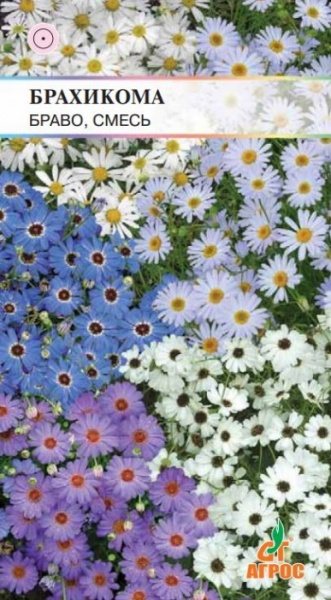

Brachikoma Bravo photo
Bravo - hybrid series has several colors of flowers, forms a densely branched, broadly rounded, dense bush. The marginal ligulate flowers are ultramarine with a narrow light border at the base, blue, mauve, purple and white. Tubular - small, black or yellow;
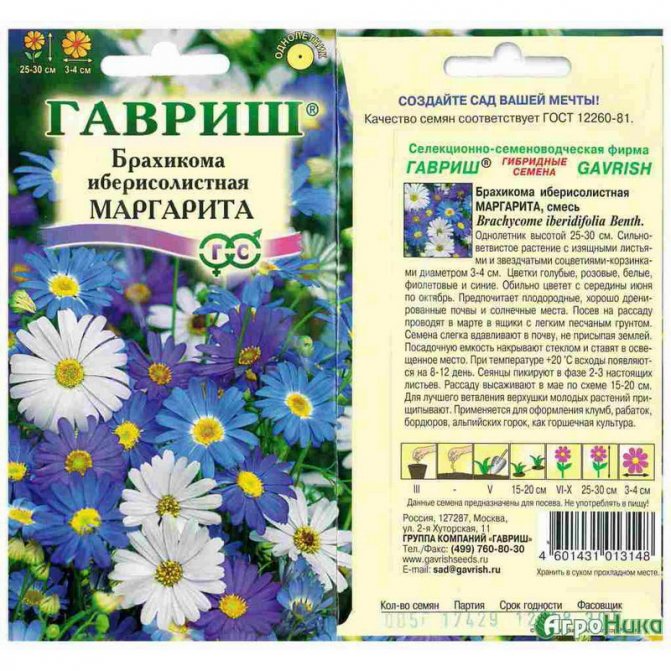

Brachikoma Margarita photo 1
Margarita - the shape of the flowers resembles miniature stars, which have a dark core, and the petals can be pink, yellow, lilac.
Brachikoma stardust photo
An interesting variety Star Scattering with beautiful large flowers, wide petals of which have a bright color. The purple, blue, white flowers planted nearby really resemble a scattering of bright stars on a green background.
Brachycoma Gorgeous photo
A good choice is the Magnificent brachicoma variety. This annual grows rapidly, covering the flower bed with luxurious inflorescences with many flowers.
Brachikoma Iberisoliferous Nega photo
A stunning ampelous variety, which is convenient to grow on the balcony and in a pots, is Brachicoma Iberis-leaved Nega: the plants are short, very thick leaves and many flowers. a real scope for the imagination of a florist!


Brachycoma Palermo photo
A beautiful mixture of Brachikoma Palermo: pale pink, blue, purple flowers will delight all summer with abundant flowering.
Application
This is an amazing container culture. Most often, it is planted in pots, containers, pots, on loggias and balconies, and they decorate the entrance to the house. In addition, the brachycoma will decorate:
- Flower beds.
- Alpine slide.
- Curbs.
The plant is easy to shape into a ball, which means this unassuming annual can look good in regular, park-like compositions.
Combined with:
- Petunia.
- Rudbeckia.
- Ursinia.
- Gaillardia.
- Coreopsis.
- Zinnias.
In general, any letniki with large and rough flowers will approach, a delicate cloud of brachicoma will set them off and accentuate the brightness of their colors.
Landing in open ground
This is a thermophilic plant, therefore, it is planted in open soil after warm weather has settled on the street.
So that everything goes perfectly and not a single sprout dies, shortly before transplanting it is tamed to fresh air, taking it outside for several hours during the day. Usually, a transplant is done in May or early June, the main thing is that, according to the forecast, there is no frost.
And you need to have time to make a transplant before the first flowers appear, which begin to bloom two months after planting the seeds. It is not scary if the first flowers appeared already at the time of transplantation. It can be transplanted both into open ground and into street flower beds.
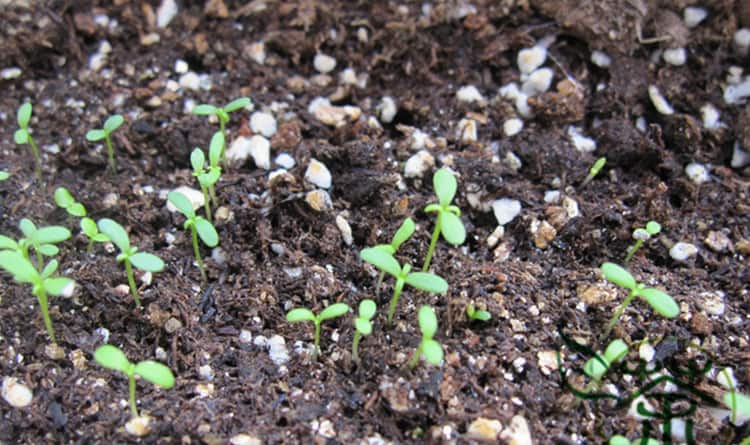

The distance between the shoots should be at least 30 cm, as they grow strongly and in cramped conditions they will not look very decorative.
The bottom of the soil must be drained, since the flower does not tolerate excess moisture in the earth. The soil itself should be neutral in acidity. They are planted shallowly and with the ground from the pot, trying not to ground the root collar.
Watering
Since it spread around the world from Australia, where a dry and hot climate prevails, it rarely needs to be watered.Make sure that the soil is not constantly wet, as the roots of the flower can rot. Most often, a flower is watered only in complete drought and during its active growth.
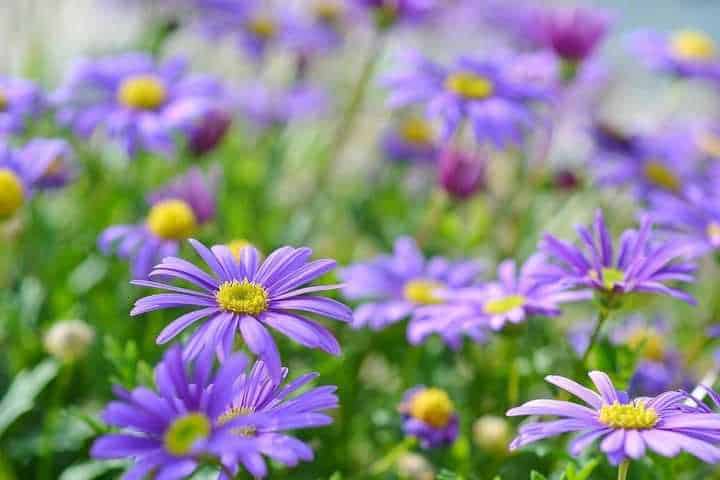

After each watering, it is imperative to loosen the soil so that the roots receive oxygen. If the summer is rainy, then sprinkle pine needles or ash around the bushes so that the snails do not get close to the flower.
Decay of roots
Every brachicoma bush inevitably collides with rotten roots after a long rainy summer. Therefore, so that the roots do not rot, before planting, the gardener must take care of the drainage layer, which will save the plant from waterlogging of the soil.
If there is no drainage layer, then the bushes need to be transplanted to another, drier place. During transplantation, the affected roots are cut off and disinfected with a solution of potassium permanganate.
[collapse]
Timing
Under normal climatic conditions, seedlings are sown from mid-March. It takes about two months for the shoots to get stronger and take shape. If all the steps and recommendations were followed correctly, then flowering will begin soon after planting and last until autumn.
Judging by the changes in the climate over the past years, all dates can move forward by about a couple of weeks - in order to know the exact time of planting seedlings in open ground, you need to monitor the weather and forecasts.
